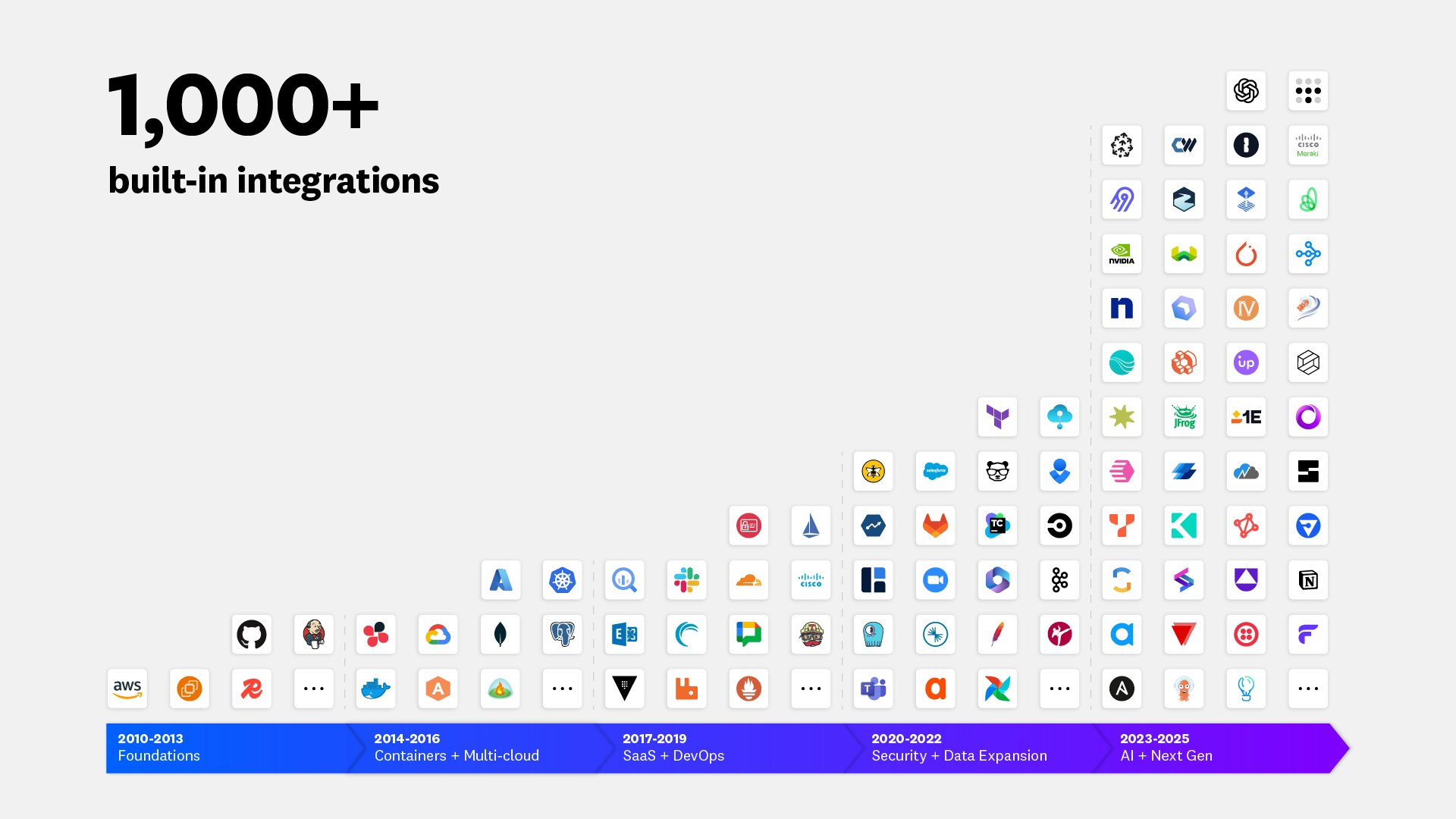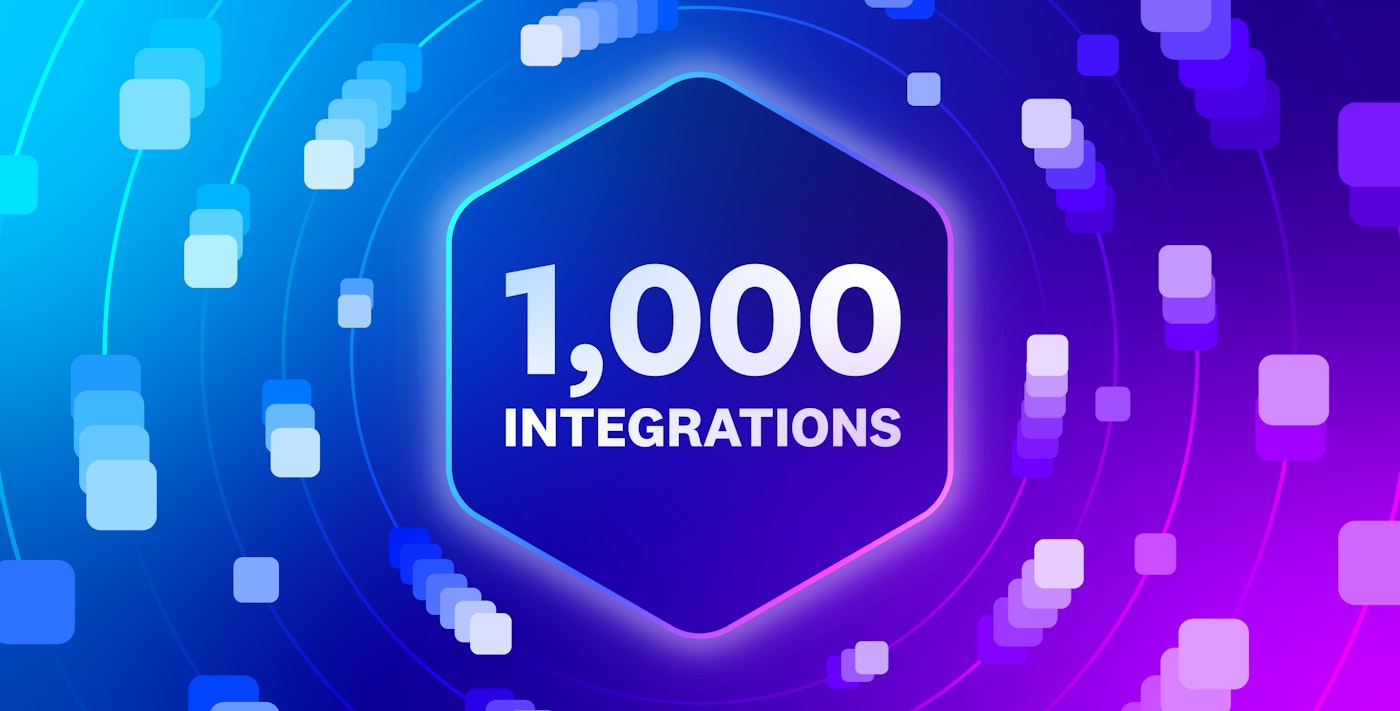
Alex Guo

Erica Ho
Integrations have always been central to the Datadog platform, enabling customers to collect the data they need directly from the technologies they use every day. By unifying signals from infrastructure and applications to security and SaaS applications, teams gain both high-level visibility and the ability to drill into the details that matter the most.
With more than 1,000 integrations now available, the Datadog ecosystem continues to expand alongside the platforms our customers rely on. Reaching this milestone reflects both the breadth of our coverage and the trust customers place in Datadog to help them monitor the technologies they adopt next.
The evolution of our ecosystem
From the start, Datadog set out to give DevOps engineers full visibility into their entire environments by collecting and correlating data from the technologies they rely on. That began with the Datadog Agent, a lightweight way to capture granular host metrics. As infrastructure modernized, coverage soon expanded to major cloud providers such as AWS, Google Cloud, and Azure, which remain among our most widely used integrations. In the past year, the number of organizations monitoring hosts, including cloud services, with Datadog has grown by 20%, showing how cloud integrations remain critical as customers scale.
As customer stacks evolved, we’ve expanded our integrations to match. For example, we built integrations for container and orchestration platforms like Kubernetes, as they became central to customer environments, followed by serverless services and a wide range of SaaS applications. Today, most organizations on Datadog run containers, and 99% rely on our container integrations as they re-architect their systems for elasticity, portability, and speed.

Over the past two years, security and AI have driven a new wave of integrations. To match this growth, the majority of our security and AI integrations have been built in this period, reflecting the rapid adoption of these technologies.
As systems become more distributed, the attack surface broadens. To address growing risks, we’ve added new security integrations that give customers broader visibility into their environments. Currently, 15% of services remain vulnerable to known exploited flaws, affecting nearly a third of organizations. To help customers address this, we’ve added integrations for cloud activity, identity, and endpoint telemetry through services like AWS CloudTrail, Okta, and CrowdStrike. These enable teams to investigate performance issues and security events in the same workflows, with full context.
Advances in AI have led us to monitor GPUs, vector databases, and LLM providers such as OpenAI, Anthropic, and LangChain. Through these integrations, organizations are already sending hundreds of millions of LLM spans through Datadog each month, showing both the scale of the adoption and how customers are monitoring AI workloads in production.
To keep pace with customer needs and the technologies they adopt, Datadog reinvests more than 30% of revenue into R&D. Much of this investment goes toward frameworks, tooling, and test infrastructure that enables us to deliver new integrations quickly and consistently.
Integration adoption
Customers combine integrations in different ways to solve everyday problems. By connecting them into their stack and collecting data from each technology, they can correlate disparate data types for deeper analysis. For example, many pair cloud and security data to catch misconfigurations faster, often correlating cloud activity logs with identity and endpoint data. Teams use APM with error tracking to trace failing requests and link them with error-reporting tools for faster debugging. On the frontend, RUM paired with analytics integrations shows how application performance affects customer experience and engagement. And in day-to-day operations, customers connect infrastructure telemetry with collaboration tools like Slack or PagerDuty to reduce mean time to resolution (MTTR) by surfacing alerts where they already work.
Cloud adoption patterns mirror shifts in how organizations are evolving their systems. Multi-cloud is now the norm as companies spread workloads across providers and regions to ensure portability and resilience. To meet this demand, Datadog has expanded availability to new regions, including Australia and New Zealand. Currently, 13% of our customers use Datadog to monitor two or more cloud providers, with adoption steadily increasing over time.
Open standards are gaining traction, with OpenTelemetry adoption on Datadog up nearly 55% in the past year. Customers also want fewer handoffs across their organization, so they are connecting data platforms like Snowflake directly into Datadog, which helps reduce silos between engineering, security, and business teams. Together, these patterns show that integrations are not only about coverage but about connecting workflows. By unifying signals across categories, customers can resolve issues faster and work more efficiently.
Building the ecosystem
We’ve invested in making integrations easier to build, test, and maintain. Our platform teams have introduced standardized frameworks, common tooling, and support for new data formats such as OpenLineage events and tabular data. These changes help teams create high-quality integrations that can power Datadog’s growing set of products.
Recently, we added a developer platform that streamlines integration development and allows integrations to prepackage content like dashboards, monitors, and SIEM detection rules, with App blueprints coming soon. These enhancements include support for secure authorization protocols like OAuth, which make it easier for partners to build integrations and for customers to enable them without managing sensitive credentials. By aligning with OpenTelemetry semantic conventions, integrations remain consistent, portable, and adaptable as observability evolves.
Datadog teams are embedding AI into every stage of the integration workflow, from improving technical design documents to reducing time to first working version and piloting systems that suggest potential causes of support tickets. Combined with partner contributions, this R&D keeps the ecosystem expanding while maintaining the reliability and standards customers expect.
Scaling the ecosystem with our partners
Datadog’s ecosystem doesn’t grow on its own. Our partners are critical to its growth and success. Roughly a third of our integrations are developed by registered technology partners, giving customers visibility into new tools and services as soon as they adopt them. These efforts strengthen the platform for both sides. Customers benefit from native integrations that let them correlate data across their stack, while partners reach more users through the Datadog platform.
The Datadog Partner Network provides technology partners with tools, resources, and support to build, validate, and scale integrations. This collaboration enables partners to deliver reliable integrations to customers by giving them immediate access to new functionality. These partnerships extend across providers such as AWS, Google Cloud, Azure, ServiceNow, and Cloudflare, along with a growing number of AI-native platforms, and play a central role in delivering new capabilities to customers.
The future of our ecosystem
Reaching 1,000 integrations is a milestone, not our finish line. As the technological landscape evolves, new categories will emerge and others will expand. Datadog will continue investing in the frameworks and partner work that help customers monitor new technologies while maintaining the coverage they use today. Thanks to our customers and partners for contributing to this growth.
Explore our integrations
Browse the Datadog Integrations page to see how Datadog can help you monitor everything from core infrastructure to AI workloads. If you don’t already have an account, you can sign up for a 14-day free trial to get started.

